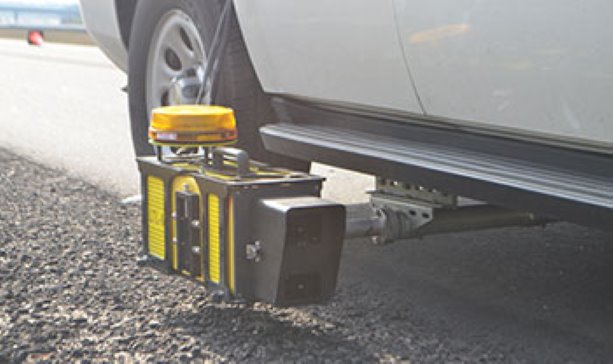The Ontario Ministry of Transportation (MTO) is the first jurisdiction in North America to use the Delta LTL-M mobile retroreflectometer. Instead of monitoring the retro-reflectivity of pavement markings by driving at night and eyeballing the road subjectively, MTO staff can now cover hundreds of kilometres and let the technology do the work.
There’s nothing quite like a drive in a great set of wheels along a great road — unless the pavement markers are missing or faded.
Then it becomes a bit of a nightmare, never knowing literally what’s coming up next because those lines give drivers context and visual clues as to where that road is going to twist or bend ahead.
Those markers are even more critical in wet conditions or at night. To function as designed, the luminosity or reflectivity of the paint must hold up over time despite a daily barrage of sunlight and tires trundling over it.
It’s not enough just to mark the lines; they must be monitored and measured over time to ensure they are meeting the Ontario Ministry of Transportation’s (MTO) standard for retroreflectivity.
Performing that task was, until fairly recently, a laborious and time-consuming process but new technology recently adopted by the MTO seems to be breaking new ground.
In fact, Ontario is the first jurisdiction in North America to use the Delta LTL-M mobile retroreflectometer.
Instead of monitoring the retro-reflectivity of pavement markings by driving at night and eyeballing the road subjectively, MTO staff can now cover hundreds of kilometres and let the technology do the work. And instead of having to return to problem spots in the daytime to have another inspection, everything can be done digitally with just one pass.
Older hand-held retroreflectometers needed a couple of dozen readings and traffic control support and involved some risk to the operator who was working near live traffic lanes.
The new system involves fitting a retroreflectometer to a vehicle and then driving at regular posted speeds along highways to take readings on the fly.
There are two operators in a car: one to drive and other to monitor the equipment and readings on a tablet computer, adjusting for weather or other external environmental changes which may affect the data. In a sense, the vehicle is transformed into a mobile laboratory.
“It’s a standard Tahoe and all the equipment except the sensor is inside,” said Grant Ridley, a chemical engineer, in the MTO concrete section. “It sits about 10 cm off the road and we can do one line at a time, either the centre line or the edge line on each pass.”
The sensor captures 25 images of a metre-wide section each second in unison with a synchronized strobe which is then processed by a computer and fed wirelessly to the passenger who has an Android tablet and can monitor the data and make notations regarding dirt, debris and other issues.
“We can do about 700 km a day, working 10 hours a day,” he said. “We have three marine batteries, one in use and one charging and when we get to the hotel for the night we pull the data in to a USB hard drive and then put it into my computer and we also put the batteries on to charge.”
The system, which is similar to those offered by three other manufacturers, costs about $150,000, not including the vehicle, is being used on roads under area maintenance contracts where the contractor is responsible for ensuring roads meet the specifications, among them pavement-marking standards.
There’s even a HD video camera mounted on the windshield which also incorporates data on the fly to add to a visual check.
Because the system works on the fly, there’s no need to stop and no need to set up traffic controls. Instead of taking 10 minutes to perform 25 measurements, the Delta LTL-M takes 25 data samples a second while measuring the road width and checking colour contrast. It can be operated night or day but not in the wet because spray will interfere with the optics.
So far, it’s proved a huge success. It’s faster and cheaper than the old way of doing things and in one test run covered 3,000 kilometres of highway in just 10 days.
Still, it won’t completely replace hand-held units which will be used for problematic areas where more detail is required and where hands-on data capture is needed to provide evidence in a dispute between a contractor and MTO over reflectivity.



Recent Comments
comments for this post are closed